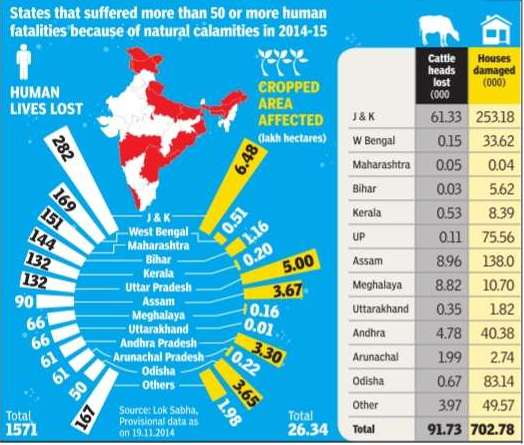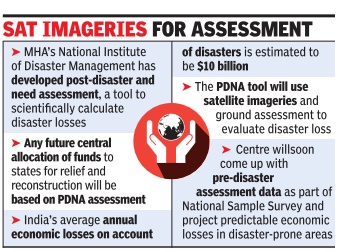Natural disasters, calamities: India
(→Loss due to disasters) |
(→The toll) |
||
| Line 166: | Line 166: | ||
“In such a scenario, mobile companies can play a proactive role in helping disseminate information in a particular district or hamlet by sending alerts,“ IMD director general K J Ramesh said. | “In such a scenario, mobile companies can play a proactive role in helping disseminate information in a particular district or hamlet by sending alerts,“ IMD director general K J Ramesh said. | ||
| + | |||
| + | ==2018-19: 2,400 die due to extreme weather== | ||
| + | [https://epaper.timesgroup.com/olive/ODN/TimesOfIndia/shared/ShowArticle.aspx?doc=TOIDEL%2F2019%2F07%2F09&entity=Ar01208&sk=54A17E48&mode=text July 9, 2019: ''The Times of India''] | ||
| + | |||
| + | Over 2,400 people died in India due to extreme weather events in the last one year, the government informed Rajya Sabha. Though it said global warming may lead to increase in frequency or intensity of weather events, it denied any “direct” linkages between natural disasters and climate change. | ||
| + | |||
| + | “As per information received from the ministry of home affairs, 2,405 lives have been reported to be lost during the financial year 2018-19 in India due to cyclonic storms/ flash floods/landslides/cloudbursts etc,” minister of state for environment Babul Supriyo said. “India experienced 431 major natural disasters between 1980-2010, resulting in loss of human lives, property and resources,” the minister added. | ||
| + | |||
| + | Referring to steps taken by government to tackle the issue, Supriyo said the National Action Plan on Climate Change, which comprises missions in specific areas of solar energy, energy efficiency, water, agriculture, Himalayan ecosystem, sustainable habitat, green India and strategic knowledge on climate change, was being implemented. | ||
| + | |||
| + | [[Category:Bangladesh|D | ||
| + | NATURAL DISASTERS, CALAMITIES: INDIA]] | ||
| + | [[Category:Development|D | ||
| + | NATURAL DISASTERS, CALAMITIES: INDIA]] | ||
| + | [[Category:Government|D | ||
| + | NATURAL DISASTERS, CALAMITIES: INDIA]] | ||
| + | [[Category:India|D | ||
| + | NATURAL DISASTERS, CALAMITIES: INDIA]] | ||
| + | [[Category:Natural Disasters|N | ||
| + | NATURAL DISASTERS, CALAMITIES: INDIA]] | ||
| + | [[Category:Pages with broken file links|NATURAL DISASTERS, CALAMITIES: INDIA]] | ||
= Vulnerability to climate extremes= | = Vulnerability to climate extremes= | ||
Revision as of 14:46, 16 December 2020
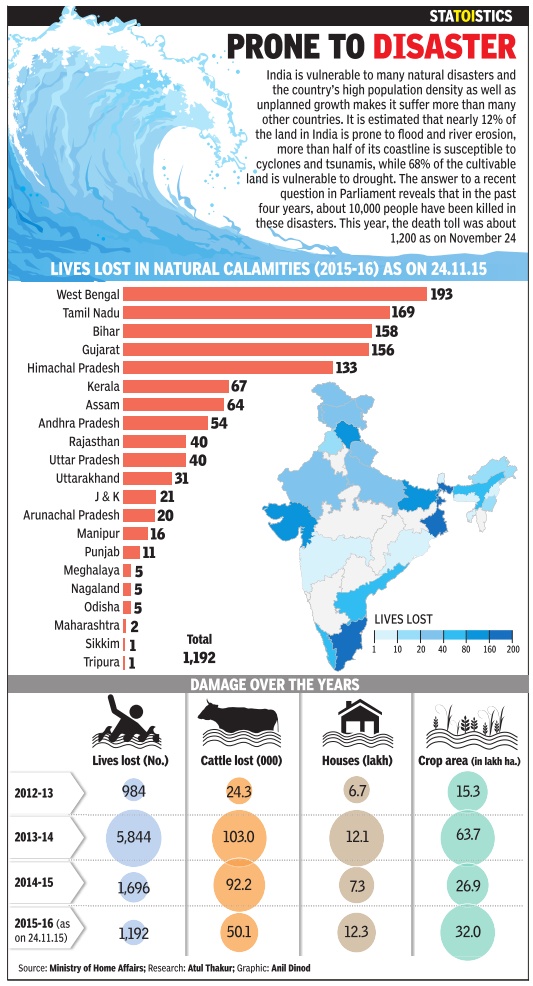
This is a collection of articles archived for the excellence of their content. |
Contents |
Chronology of disasters
1995-2015
The Times of India, Nov 25 2015
`India 3rd worst affected by natural disasters in 20 yrs'
India ranks third, after the US and China, among the five countries hit the most by natural disasters over the last 20 years, a report released by the United Nations office on disaster risk reduction has said. The Philippines and Indonesia round up the top five. `The Human Cost of Weather Related Disasters', released on Monday by the UN Office for Disaster Risk Reduction (UNISDR), showed that over the last two decades, 90% of major disasters were caused by 6,457 recorded floods, storms, heat waves, droughts and other weatherrelated events.
“Since the first climate change conference (COP1) in 1995, 606,000 lives have been lost and 4.1 billion people have been injured, left homeless or in need of emergency assistance as a result of weather-related disasters,“ the report said.
The UNISDR observed data gaps on the extent of economic losses from weatherrelated disasters as they are much higher than the recorded figure of $1.9 trillion.“Only 35% of records include information about economic losses,“ it said, and estimated that the true figure on disaster losses, including earthquakes and tsunamis, was between $250 billion and $300 billion annually .
Releasing the report, UNISDR head Margareta Wahlstrom said, “In the long term, an agreement in Paris at COP21 on reducing greenhouse gas emissions will be a significant contribution to reducing damage and loss from disasters which are partly driven by a warming globe and rising sea levels.“ For now, she said, there was a need to reduce existing levels of risk and avoid creating new risks.
2014
December 16, 2014
See graphic:
State- wise impact of natural disasters in India(2014-15)
India witnesses huge loss of human life and property because of natural calamities. Apart from the floods that annually hit states of Bihar, West Bengal and Assam and the cyclones that hit the coastal states, 2014 also saw flooding in J&K and a massive landslide in Maharashtra.As on November 19, 2014, natural calamities resulted in the loss of over 1,500 lives across the country. More than 7 lakh houses were damaged and about one lakh heads of cattle were lost.
2018
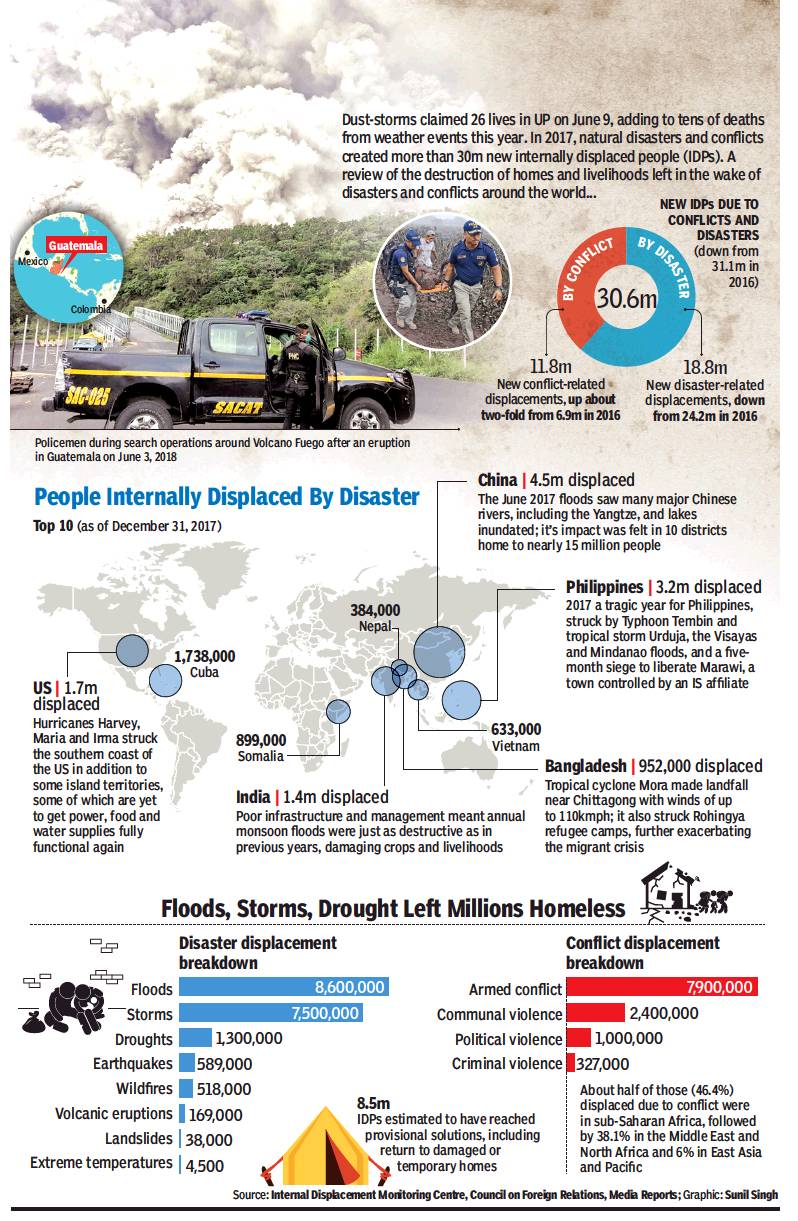
From: June 19, 2018: The Times of India
See graphic:
Natural disasters in Bangladesh, China, India and the world- 2017
Disaster Displacement
India, China, Bangladesh worst affected/ 2016
Pradeep Thakur, Calamities displace 23L every year, October 13, 2017: The Times of India
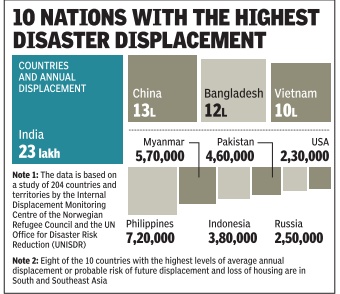
From: Pradeep Thakur, Calamities displace 23L every year, October 13, 2017: The Times of India
India ranks the highest among the world's most disaster-prone countries for displacement of residents, with 23 lakh, on average, uprooted due to calamities such as floods, cyclones and earthquakes.
A UN study , to be released on the International Day for Disaster Reduction on Friday , forecast a continued rise in homelessness. China, with annual average displacement of 13 lakh, ranks second (see graphic).
The estimation of displaced people in India may be on the lower side considering that, in the recent Bihar floods alone, about 1.75 crore were affected and 8.55 lakh evacuat ed. Floods hit at least half a dozen other states n 2017.
“Most of this displace ment is being driven by flooding, which is on the increase in a warming world where population growth in hazardprone parts of the globe has increased exposure,“ said the study , conducted by the Internal Displacement Monitoring Centre of the Norwegian Refugee Council and the UN Office for Disaster Risk Reduction (UNISDR).
Robert Glasser, the UN secretary general's special representative for disaster risk reduction (DRR), said the issue had come into sharp focus as the world coped with a record-breaking Atlantic hurricane season, and record floods across Bangladesh, India and Nepal.
The study , `A Global Disaster Displacement Risk Model', does not include slow onset disasters attributed to drought and sea-level rise, the UNISDR said.
Ex gratia payment/ compensation by government
HC: Treat lightning like other natural calamities
Ajay Sura, Compensate for lightning death: HC, April 29, 2018: The Times of India
The Punjab and Haryana HC has clarified that the death of a person after a lightning strike cannot be an “act of god” and that such cases should be treated like any other natural calamity. The court has also said that “lightning can be compared with earthquake and tsunami, for which no person can be held responsible and which may strike at any time”.
Justice Rakesh Kumar Jain passed these orders while allowing a petition filed by a Tarn Taran resident, who approached the court after Punjab government officials refused to give him compensation for the death of his pregnant wife due to lightning.
Lakhwinder Singh and his wife were both working as labourers at a brick kiln on January 18, 2009 when she was struck by lightning and died.
The court directed the Tarn Taran administration to consider Lakhwinder’s case and award appropriate compensation within a period of three months.
Lightning strikes: India
2014: Deaths caused by lightning
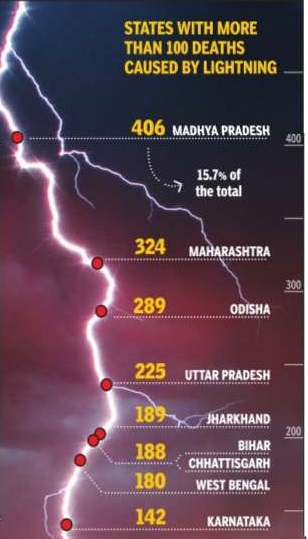
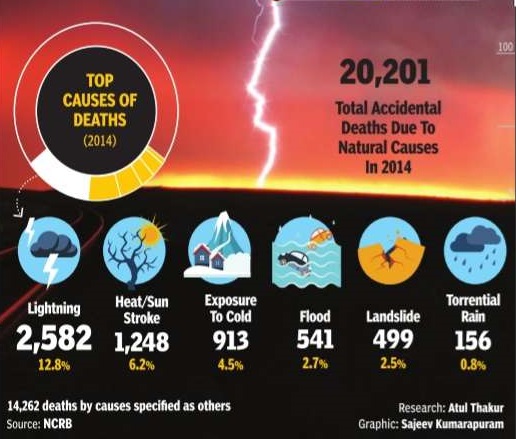
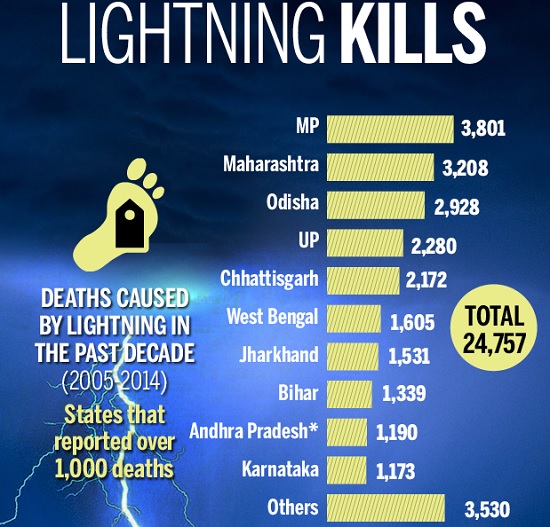
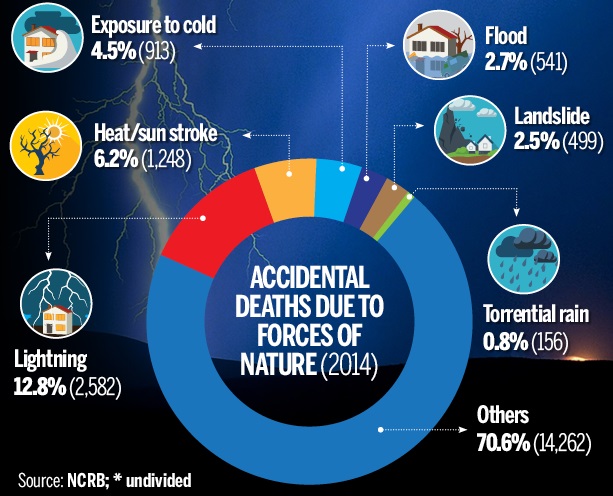
The Times of India, Sep 08 2015
In 2014, more than 20,000 people were killed by accidents caused by forces of nature.Among the known reasons of these deaths, the largest chunk were due to lightning, which alone killed more than 2,500 people. It was followed by heat sun stroke, exposure to cold and flood, each causing more than 500 deaths. A state-wise comparison of lightning deaths shows that the highest number of causalities was reported in Madhya Pradesh, where over 400 people lost their lives.Andhra Pradesh, where 19 people got killed by multiple lightning strikes on Sunday, witnessed 69 deaths in 2014.
Loss due to disasters
1998-2017: India lost $80bn, 4th worst in world
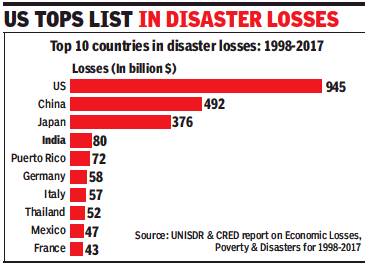
From: Pradeep Thakur, Natural disasters cost India $80bn in 20 yrs: UN report, October 11, 2018: The Times of India
Climate change is making development highly risky, particularly in lower-middle income countries like India. A study released by the UN office for Disaster Risk Reduction (UNISDR) on Wednesday said India suffered economic losses of $80 billion during the 20-year period of 1998 to 2017.
India has been ranked among world’s top five countries in absolute economic losses. Globally, disaster losses during this period have been estimated at $3 trillion. These losses have increased by more than 120% in the last 20 years compared to the preceding two decades (1978-1997). And if we just account for climate related disaster losses, they have gone up by more than 151%.
Mami Mizutori, head of UNISDR, said: “The report makes it clear that economic losses from extreme weather events are unsustainable and a major brake on eradicating poverty in hazard exposed parts of the world.” She emphasised on the need for countries to capture economic losses which can help in disaster mitigation, saving lives and livelihoods.
“In the period 1998-2017, disaster-hit countries reported direct economic losses of $2,908 billion of which climate-related disasters accounted for $2,245 billion or 77% of the total. This compares with total reported losses for the period 1978-1997 of $1,313 billion of which climate-related disasters accounted for $895 billion or 68%,” the UNISDR said.
“It is also clear that the economic losses suffered by low and lower-middle income countries have crippling consequences for their future development and undermine our efforts to achieve the 17 Sustainable Development Goals, in particular the eradication of poverty,” the UNISDR said. The study was jointly conducted by UNIDR and Centre for Research on the Epidemiology of Disasters (CRED) and released before October 13, the International Day for Disaster Reduction.
In the last 20 years, climate-related disasters killed 1.3 million people and left 4.4 billion injured and homeless. India is worst sufferer of disaster-related deaths and economic losses. Thousands of human lives are lost and hundreds of crores worth of properties destroyed every year, though not all of them are reported, a fact authenticated by the UN report that said loss data is not available for 87% of disasters in low income countries. “While the majority of fatalities were due to geophysical events, mostly earthquakes and tsunamis, 91% of all disasters were caused by floods, storms, droughts, heat waves and other extreme weather events,” the report said.
Storms, floods and earthquakes are not just common to India. In fact, three European countries are in the top 10 nations having suffered maximum economic losses on account of these climate change disasters — France ($48 billion), Germany ($58 billion) and Italy ($57 billion).
2016: Govt develops scientific tool to measure loss
Country Suffers $10bn Economic Damages Per Yr
The government has developed a scientific tool based on a UN model which will use satellite imagery and on-ground assessments to measure direct and indirect damages besides the `opportunity cost' lost due to disasters. This will help the Centre make a more accurate and scientific assessment of relief and reconstruction packages for disaster-hit regions, and not be dependent on the arbitrary claims made by states.
India's estimated economic losses are pegged at around $10 billion annually on account of disasters -almost equal to what the country spends on education and twice the amount it spends on healthcare every year.Globally , climate change resulted in economic losses of around $300 billion annually , according to the UN Office for Disaster Risk Reduction's (UNISDR) global assessment report-2015.
The scientific tool, called the Post Disaster Need Assessment (PDNA), has been developed by the National Institute of Disaster Management (NIDM), a part of the home ministry . It is ready for trials and a pilot will run in a calamityhit region. The tool has been designed to meet Indian conditions, though modelled on the lines of a similar tool used by the UNISDR for Latin American countries. The UNISDR tool was developed by the Economic Commission for Latin America and the Caribbean and is known as ECLAC tool for disaster risk reduction and loss assessments.
The government is also likely to engage the ministry of statistics and programme implementation to collect and publish pre-disaster as sessment data as part of the national sample survey and project predictable economic losses in disaster prone areas. This is intended to nudge states to invest more in disaster resilient infrastructure and implement disaster risk reduction policies.
“The PDNA tool will estimate cost of reconstruction, rehabilitation and measures required for disaster risk reduction (DRR) in addition to the opportunity cost,“ said Santosh Kumar, executive director of NIDM. A first-of-itskind tool, it will count opportunity cost, or the economic loss caused by interruption of services due to disasters as part of the total loss due to disasters. So far, compensation packages are estimated based on property damaged and lives lost.
The NIDM has prepared a manual for implementation of the PDNA tool and has put in place a module for training of people engaged in DRR activities. A home ministry funded project, the initiative is designed for India's long-term disaster recovery measures that would help it prioritise investment in social and infrastructure sector.
In India, the first scientific calculation of economic losses and reconstruction work, based on the ECLAC tool, was undertaken in Gujarat after the Bhuj earthquake of 2001 which killed around 20,000 people and destroyed at least 4 lakh houses. The then Gujarat government, headed by then chief minister Narendra Modi, had used the tool to assess economic losses and designed a new model of development based on resilient buildings and public infrastructure.
The toll
2016: Heat, flood, cold & lightning killed 1,600
The Times of India, Jan 16 2017
Heat, flood, cold & lightning killed 1,600 in 2016
More than 1,600 people died due to extreme weather conditions across the country last year, with severe heat wave claiming the largest chunk of the total deaths at 40%, followed by flooding and lightning.
The IMD said 2016 was the warmest year ever recorded, globally as well as in India.Phalodi in Rajasthan recorded 51degrees Celsius, highest ever recorded in the country.
January and February were the warmest winter months ever, according to IMD, which records weather patterns since 1901.
Bihar, Gujarat and Maharashtra topped the casualty list with the states contributing 35% of the total. They to gether recorded 552 deaths due to extreme weather patterns.
According to a report by India Meteorological Department (IMD), 40% of the total deaths were due to severe heat wave, which claimed more than 700 lives in the country , with Telangana and Andhra Pradesh together recording the maximum deaths i.e more than 400. Gujarat and Maharashtra registered 87 and 43 deaths due to heat waves respectively. Cold wave claimed 53 lives in the country.
Lightning claimed more than 415 lives and the worst hit were the eastern states of Bihar, Odisha, MP and UP.
Odisha alone recorded more than 132 deaths due to lightning while 43 deaths occurred in Maharashtra.
IMD last year started issuing summer and winter forecasts with heat wave and cold wave warnings. After two consecutive droughts, India last year had a normal monsoon, but several parts of the country witnessed heavy to very heavy rainfall, causing flooding in many areas.
More than 475 lives were lost in floods and thunderstorms. Bihar alone saw near ly 146 deaths due to flooding between July 25 to September 3.
2016 saw four cyclonic storms in Bay of Bengal, the major being severe cyclonic storm Vardah, which killed 18 people in Tamil Nadu.
“We have tried to minimise the loss of lives, especially in large scale events like cyclones and heavy rains. For example, accurate predictions helped minimise loss of lives during Vardah and prediction of heavy rains. But when it comes to events like lightning, it becomes difficult as at several instances it takes places in villages and hamlets.“
“In such a scenario, mobile companies can play a proactive role in helping disseminate information in a particular district or hamlet by sending alerts,“ IMD director general K J Ramesh said.
2018-19: 2,400 die due to extreme weather
July 9, 2019: The Times of India
Over 2,400 people died in India due to extreme weather events in the last one year, the government informed Rajya Sabha. Though it said global warming may lead to increase in frequency or intensity of weather events, it denied any “direct” linkages between natural disasters and climate change.
“As per information received from the ministry of home affairs, 2,405 lives have been reported to be lost during the financial year 2018-19 in India due to cyclonic storms/ flash floods/landslides/cloudbursts etc,” minister of state for environment Babul Supriyo said. “India experienced 431 major natural disasters between 1980-2010, resulting in loss of human lives, property and resources,” the minister added.
Referring to steps taken by government to tackle the issue, Supriyo said the National Action Plan on Climate Change, which comprises missions in specific areas of solar energy, energy efficiency, water, agriculture, Himalayan ecosystem, sustainable habitat, green India and strategic knowledge on climate change, was being implemented.
Vulnerability to climate extremes
India 6th worst
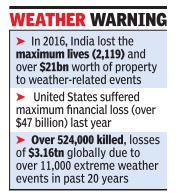
From: Vishwa Mohan, India 6th among nations most vulnerable to climate extremes, November 10, 2017: The Times of India
India has been ranked as the sixth most vulnerable country in the world in terms of facing extreme weather events, with Haiti, Zimbabwe, Fiji, Sri Lanka and Vietnam taking the top five positions in a fresh list of nations facing climate risk.
The US, Taiwan, Macedonia and Bolivia are the other countries that make up the top 10 of the global Climate Risk Index (CRI) by Berlin based NGO German watch. CRI is based on an analysis of the number of deaths (due to climatic conditions) per 100,000 inhabitants, extent of financial losses and loss per unit of GDP of countries. India was at number four last year in CRI ranking. Economic and population data from IMF were taken into account while arriving at the rankings.The report noted that in 2016, India lost the maximum number of lives (2,119) and over $21 billion worth of property to weather-related events. The US suffered the maximum financial loss (over $47 billion) last year. Analysing the relevant data of the past 20 years (1997-2016), the CRI report found that over 524,000 lives were lost and the world suffered financial losses to the tune of $3.16 trillion as a direct result of more than 11,000 extreme weather events during the period.
In the present analysis, only weather-related events -storms, floods and er-related events -storms, floods and extreme temperatures (heat and cold waves) -are incorporated.
“Geological incidents like earthquakes, volcanic eruptions or tsunamis, for which data is also available, are not relevant in this context as they do not depend on the weather and, therefore, are not possibly related to climate change,“ said the report.
India figured at 12th position in the long-term (1997-2016) CRI of countries while the 10 most vulnerable countries were Honduras, Haiti, Myanmar, Nicaragua, the Philippines, Bangladesh, Pakistan, Vietnam, Thailand and the Dominican Republic.
“The CRI does not provide an all-encompassing analysis of the risk of anthropogenic climate change but should be seen as just one analysis explaining countries' exposure and vulnerability to climate-related risk based on the most reliable quantified data. It is based on the current and past climate variability and also on climate change,“ said the report.
Referring to the CRI, the report advised the high-ranking countries to consider the index as a “warning sign“ that they are at risk of either frequent extreme weather events or, in rare cases, extraordinary catastrophes.
